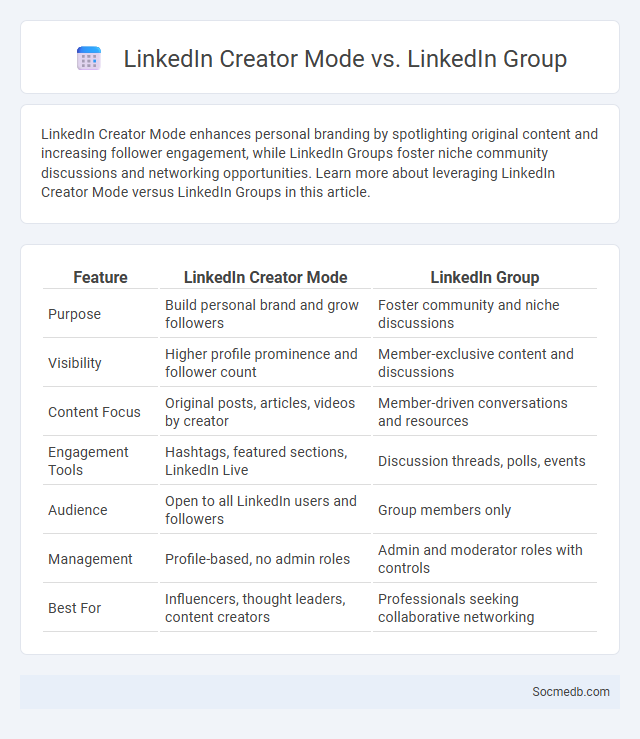
Photo illustration: LinkedIn Creator Mode vs LinkedIn Group
LinkedIn Creator Mode enhances personal branding by spotlighting original content and increasing follower engagement, while LinkedIn Groups foster niche community discussions and networking opportunities. Learn more about leveraging LinkedIn Creator Mode versus LinkedIn Groups in this article.
Table of Comparison
| Feature | LinkedIn Creator Mode | LinkedIn Group |
|---|---|---|
| Purpose | Build personal brand and grow followers | Foster community and niche discussions |
| Visibility | Higher profile prominence and follower count | Member-exclusive content and discussions |
| Content Focus | Original posts, articles, videos by creator | Member-driven conversations and resources |
| Engagement Tools | Hashtags, featured sections, LinkedIn Live | Discussion threads, polls, events |
| Audience | Open to all LinkedIn users and followers | Group members only |
| Management | Profile-based, no admin roles | Admin and moderator roles with controls |
| Best For | Influencers, thought leaders, content creators | Professionals seeking collaborative networking |
Understanding LinkedIn Creator Mode
LinkedIn Creator Mode enhances user profiles by unlocking features designed for content creators, such as follower growth tools and access to LinkedIn Live broadcasts. Activating Creator Mode improves visibility in feeds by prioritizing content distribution, leading to increased engagement and professional networking opportunities. This mode integrates with LinkedIn's algorithm to boost reach and connect creators with industry-specific audiences, fostering career development and thought leadership.
Exploring LinkedIn Groups
LinkedIn Groups offer a powerful way to connect with professionals in your industry, expanding your network and gaining valuable insights. By participating in relevant discussions and sharing expertise, you can establish your authority and attract opportunities tailored to your career goals. Engaging actively in these communities enhances your visibility and helps you stay updated on industry trends and job openings.
Defining Niche Online Communities
Niche online communities on social media are specialized groups centered around specific interests, hobbies, or professions, fostering targeted engagement and deeper connections. Platforms like Reddit, Discord, and Facebook Groups host millions of niche communities ranging from rare book collectors to AI enthusiasts, enabling users to share resources, discuss trends, and collaborate on projects. These focused environments enhance user experience by delivering tailored content, improving relevance, and driving higher interaction rates compared to broader social networks.
Audience Reach and Engagement
Maximizing audience reach on social media involves leveraging platform algorithms and targeted content to connect with your ideal demographic. High engagement rates, including likes, comments, and shares, signal relevance and boost visibility within networks. Your strategic use of analytics tools helps refine messaging and timing, driving sustained interaction and growth.
Content Creation and Sharing Features
Social media platforms offer robust content creation tools including photo and video editing, live streaming, and story templates that enhance user engagement and creativity. Sharing features such as instant posting, cross-platform integration, and audience targeting enable efficient distribution and increased visibility of content. These functionalities drive interaction, foster community building, and boost brand awareness across diverse digital channels.
Community Building Strategies
Effective community building strategies on social media include consistent content sharing, engaging directly with followers, and fostering interactive discussions to promote trust and loyalty. Utilizing targeted hashtags and user-generated content further enhances visibility and strengthens bonds within niche groups. Your commitment to authentic communication drives sustained engagement and cultivates a vibrant online community.
Networking Opportunities Compared
Social media platforms significantly expand networking opportunities by connecting you with professionals, industry leaders, and interest groups worldwide. These platforms facilitate real-time interactions, collaborations, and knowledge sharing, surpassing traditional networking limitations. Utilizing social media effectively can enhance your professional growth by increasing access to diverse contacts and timely industry insights.
Analytics and Performance Tracking
Social media analytics tools collect and analyze data on user engagement, reach, and conversion rates to optimize marketing strategies. Key performance indicators (KPIs) such as click-through rates, follower growth, and sentiment analysis provide actionable insights into campaign effectiveness. Leveraging real-time performance tracking enables brands to adjust content, improve audience targeting, and maximize return on investment (ROI).
Pros and Cons of Each Platform
Facebook offers extensive reach and diverse demographic targeting, ideal for brand awareness and community engagement, but struggles with declining organic reach and concerns over data privacy. Instagram excels in visual storytelling and influencer marketing, attracting younger audiences, yet faces challenges with algorithm changes and content saturation. Twitter enables real-time conversations and customer service interactions, though it contends with issues of misinformation and character limits that constrain detailed communication.
Choosing the Right Platform for Your Goals
Selecting the right social media platform depends largely on your specific goals, target audience, and content type. LinkedIn excels for professional networking and B2B marketing, while Instagram and TikTok thrive with visual and short-form content aimed at younger demographics. Understanding each platform's demographics, features, and engagement patterns ensures you maximize your reach and effectively connect with your audience.
 socmedb.com
socmedb.com